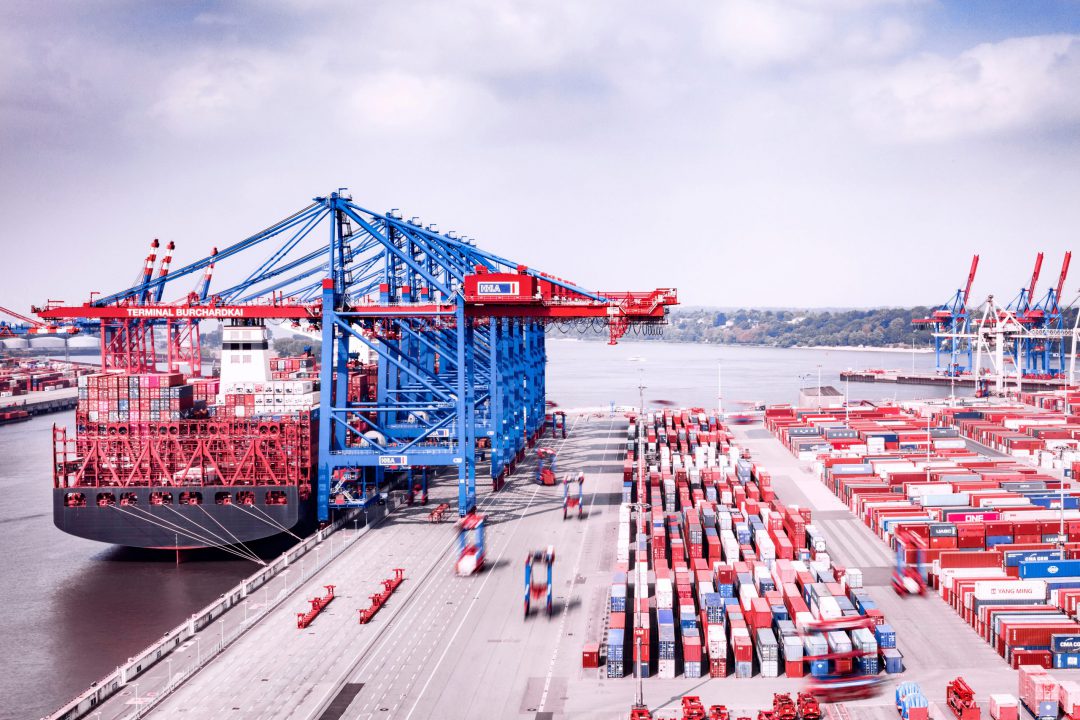The “HMM Algeciras”, with a loading capacity of 24,000 20-foot standard containers (TEU), currently the largest container ship in the world, will moor at HHLA Container Terminal Burchardkai next Sunday, June 7, 2020. The ship is expected with the evening flood around 7 p.m.
The “HMM Algeciras” is on its maiden voyage and is mooring in the port of Hamburg for the first time. During their stay, the mega freighter will load and unload around 8,500 containers or 13,600 TEU and will probably leave the terminal again around 2 p.m. on Wednesday.
The “HMM Algeciras” is the new flagship and the pride and joy of the South Korean shipping company HMM. “We are very happy to welcome the ‘HMM Algeciras’ here in Hamburg,” said James Kim, Managing Director of HMM Germany. The first call in the Hanseatic city is a milestone in the long maritime connections between South Korea and Hamburg and at the same time underlines the importance of the port of Hamburg as a hub for international sea freight traffic.
HHLA CEO Angela Titzrath confirms the company’s claim to handle ships of all sizes quickly, reliably and efficiently. “Especially in times like these, which present us with great challenges due to economic uncertainties and global upheavals, trustworthy and reliable partnerships, such as those that HHLA has maintained with its customers for many years, are the foundation for economically successful and sustainable development in Hamburg . “
Top performance at HHLA Container Terminal Burchardkai
The “HMM Algeciras” will moor at the HHLA Container Terminal Burchardkai in the Waltershofer Hafen. “HHLA is pleased that HMM is now coming to Hamburg with its largest ship units. This confirms us in our forward-looking investments in new bridge technology and storage capacities in order to be able to handle these ship sizes today, ”says Jens Hansen, board member and chief operating officer (COO) of Hamburger Hafen und Logistik AG. The corona pandemic showed how important Hamburg is as the largest German seaport for an efficient and reliable supply of companies and people in Germany and all of Europe.
Around 8,500 containers or 13,600 TEUs are to be loaded and unloaded at the CTB by Wednesday. These include consumer goods, food and beverages, textiles, electronics, machines and plant components, medical devices, basic chemical products and raw materials of all kinds. These quantities of cargo, which have to be transshipped and forwarded within a very short time, require top performance from the employees and terminal technology.
Forward-looking investments in efficient ship handling
With regard to the development of ship sizes, HHLA has prepared for such attempts with a whole package of intelligent measures in recent years. At the CTB, among other things, the automated block storage system to increase capacity and efficiency was expanded, and truck handling with pre-registration, automatic container data acquisition and self-service terminals were optimized. Furthermore, the rail capacities were expanded to further improve the inflow and outflow of container flows. Five new container gantry cranes for a third large berth at Burchardkai have just arrived. With this, HHLA creates additional capacities for handling particularly large container ships with a loading volume of 24,000 standard containers (TEU) and more.
Close economic relations between Hamburg and South Korea
HMM has been a customer of the Port of Hamburg for 30 years. The shipping company opened its own agency on the Elbe back in 1989. However, the economic ties between Hamburg and Korea go much further back. Almost 140 years ago, a Hamburg merchant founded the first German commercial agency in the East Asian country. Since then, close economic ties have developed. Germany is today South Korea’s most important trading partner in Europe. More than half of all imports for the German market are handled through the port of Hamburg.
In the container segment, South Korea with a volume of 255,000 TEU in 2019 is the 6th most important trading partner of the Port of Hamburg. In addition, a close port partnership connects the Elbe metropolis with the South Korean Busan, one of the largest container ports in the world.

























